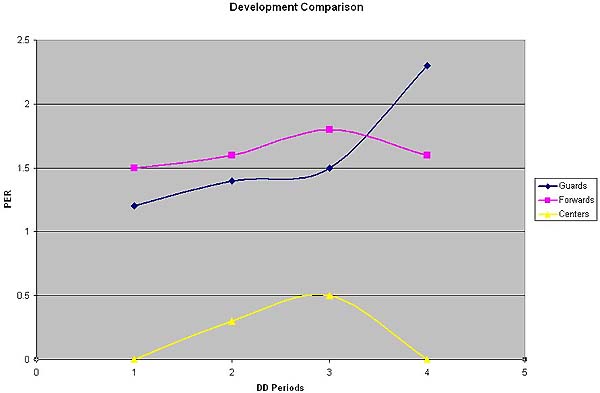
|
|
||||||||||||||||||||||||||||||||||||||||||||||||||||||||||||||||||||||||||||||||||||||||||
|
Do Centers Really Take Longer to Develop? by Jeff Wong, HoopsAddict.com, 11/17/06
As a Toronto Raptors fan, I saw our 2004 eighth-overall draft pick mercilessly booed on draft night, then in games. I read about his dedication to improvement and saw his flashes of brilliance, but two years later they're still only flashes. I thought to myself, "Be patient. Centers take longer to develop, don't they?" Hoffa's gone to Utah now, but the question remains: Do centers really take longer to develop? The answer should be in the numbers. The Method To be uncomplicated, I used John Hollinger's handy-dandy Player Efficiency Rating (PER) as the one statistic for measuring development. To be consistent, I used the draft classes of 1996–2000 to compare annual improvement by position. Also, I sifted out not-ready-for-primetime players (a.k.a. busts) by excluding those who have played less than five years of NBA ball, and ignored seasons in which less than 42 games were played (what I term "useful seasons"). That left me with a pool of 112 players. To see how the players develop over the course of their careers, I figured that the change in PER from year to year would tell the story. So, taking each player's first useful-season PER, I subtracted each succeeding useful-season PERs, giving us "Development Differentials" (DD). Theoretically, for the average player, the resulting four DDs would form a rising line or curve. For example, let's take center Chris Mihm. Here are PERs for his first five seasons:
Now we'll subtract his Year 1 PER from succeeding years' PERs, giving us an idea of how he developed:
So Mihm didn't necessarily fit the theoretical development line; it seems he suffered from the sophomore jinx. Anyway, he made significant improvement from Year 3 onward. Now applying this formula to the total pool of 112 and averaging the DDs, we get… The Results Averages of all 112 players' PERs:
Looks like I was able to filter out the busts, since these averages are pretty close to Hollinger's league average PER of 15.0. Their DDs:
This is what I expected: a rising line. Interestingly, there's a significant PER jump of 1.1 from Year 1 to Year 2. Now we separate the positions. The guards, including five guard-forwards (total 42):
Again, it's a rising line, this time with a noticeable jump in Year 5 as well. Point guards also are said to be slow developers, and it would be interesting to separate them from the rest of the backcourters — but that's another article. Forwards, including one forward-guard (Ron Mercer) and seven forward-centers (total 54):
We're losing the consistent rise here with the unexpected drop-off at Year 5. You'd think that the supposedly slow-developing centers are weighing down the forwards, but it's actually a strong forward-center group (including Jermaine O'Neal, Tim Duncan and Dirk Nowitzki) that is pushing the numbers up. Finally, The centers, including three forward-centers (total 16):
Notice this time that there is no jump in Year 2, and only marginal improvement in Years 3 and 4 before dipping, like the forwards, in Year 5. Comparing the three positions:
The Conclusion Admittedly, it was a small group of centers that was analyzed, but the results seem to support the theory: Centers DO take longer to develop. It would be interesting to expand the number of players and seasons to see if this trend is true. If so, Hoffa will reach his peak in the 2007-08 season, but will still be, in Hollinger's words, "definitely renting" or "on the first flight to Yakima." 
Jeff Wong works in the publishing industry in Toronto and is a contributing blogger at HoopsAddict.com. He can be reached by email at jeff@hoopsaddict.com.
|
||||||||||||||||||||||||||||||||||||||||||||||||||||||||||||||||||||||||||||||||||||||||||
|
|
Copyright © 2006 by 82games.com, All Rights Reserved
